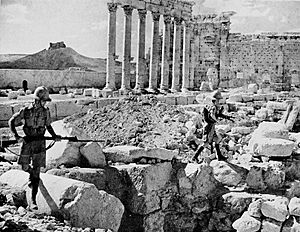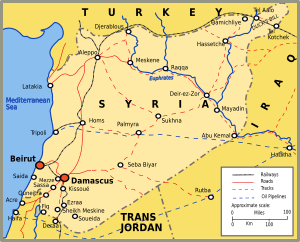Battle of Palmyra (1941) facts for kids
Quick facts for kids Battle of Palmyra |
|||||||
|---|---|---|---|---|---|---|---|
| Part of the Syria-Lebanon Campaign of World War II | |||||||
 Palmyra occupied by British Commonwealth troops after the battle |
|||||||
|
|||||||
| Belligerents | |||||||
|
|||||||
| Commanders and leaders | |||||||
| Strength | |||||||
| 1,000 | 300 | ||||||
| Casualties and losses | |||||||
| 85 killed | 135 killed 165 captured |
||||||
The Battle of Palmyra happened on July 1, 1941. It was a key part of the Syria-Lebanon campaign during World War II. In this battle, British and Arab Legion forces defeated a French army group near the city of Palmyra in Syria. This victory led to the surrender of the French troops stationed in Palmyra.
Contents
What Was the Battle of Palmyra?
The Battle of Palmyra was a fight between the Allied forces and the Vichy French army. The Vichy French were a government in France that worked with Nazi Germany during World War II. The battle took place in Syria, which was controlled by France at the time.
Why Was Palmyra Important?
In 1941, the Vichy French had many soldiers in Syria and Lebanon. They allowed German planes to use their airfields. These planes were helping Iraq fight against the British. The French also let Germany use their railways to send weapons to Iraq.
The Allies wanted to stop this. So, on June 8, 1941, they launched an attack. They moved into Lebanon and Syria from Palestine and Transjordan. By late June, the Allies had captured Damascus. Their commander, Henry Maitland Wilson, planned more attacks.
One important target was Palmyra. It was crucial for controlling an oil pipeline. This pipeline ran from Haditha in Iraq to Tripoli on the coast of Lebanon.
Who Fought in the Battle?
The British put together a special group called Habforce. This group had already helped in Iraq. Now, their job was to defeat the French in Palmyra. Habforce was good at fighting in the desert. This was because it included the Arab Legion Mechanised Regiment. These soldiers were Bedouin people who knew the desert very well.
The French forces in Palmyra were about 300 men. They were led by Commander Ghérardi. Their main defense was Fort Weygand. This fort was located near the ancient ruins of Palmyra. They also had smaller posts in the oasis and hills.
The British had about 1,000 soldiers. They were led by Major-General John Clark. These troops were part of Habforce. They included the 4th Cavalry Brigade and parts of the Arab Legion. The 1st Infantry Battalion of the Essex Regiment was also part of this force.
The Fight for Palmyra
Habforce divided into three groups. They started their advance on June 21. Each group had guides from the Arab Legion. A small fight happened near the oil pipeline. This meant the French knew the Allies were coming.
Habforce surrounded Palmyra. The Arab Legion troops went on wide patrols in the desert. They protected Habforce's sides and supply lines. On June 28, they captured a French fort called Seba' Biyar. The small French group there gave up without a fight. The next day, the Allies took Sukhna, which was not guarded by French troops.
On July 1, the French attacked Sukhna. The Arab Legion and a British cavalry group fought back. After a tough battle, the French retreated. They ended up trapped and had to surrender. This battle, though not huge, had a big effect. The French soldiers in Palmyra lost hope. They surrendered on the night of July 2.
This victory allowed Habforce to move further west. They went towards Homs. This move threatened the French forces fighting the Australian 7th Division on the Lebanese coast.
See also
- Habforce order of battle as part of Iraqforce
Images for kids



